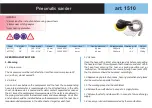
EN
G
LI
S
H
Personal safety
a) Pay attention to what you are doing and use common sense when using
an electric tool.
Do not use an electric tool if you are tired or under the
influence of drugs, alcohol or medicine. A momentary lapse in concentration
when using an electric tool can result in serious personal injury.
b) Use protective equipment. Always wear safety goggles.
Using protective
equipment such as respiratory protective equipment, non-slip safety boots,
helmet and ear protectors where necessary decreases the risk of injury.
c) Avoid starting the tool by accident.
Ensure that the switch is in the “OFF”
position before connecting the plug to the socket. Carrying an electric tool with
a finger on the switch/trigger or connecting an electric tool to the mains when
the switch is in the “ON” position could cause accidents.
d) Remove all service tools/keys before switching on the electric tool.
A forgotten service tool on a rotating part of the electric tool may result in
personal injury.
e) Do not overreach.
Ensure that your stand steady and well-balanced all the
time. This gives you better control in unexpected situations.
f) Wear suitable clothing.
Do not wear loose clothing or jewellery. Keep your
hair, clothes and gloves away from moving parts. Long hair, loose clothing or
jewellery can get caught in moving parts.
a) If a dust collector is available, ensure that it is fitted and used properly.
Using these aids can reduce the dust related health risks.
Electric tool use and maintenance
a) Do not force the electric tool.
Use an electric tool which is suitable for the
work being carried out. The correct electric tool carries out the work better and
safer at the intended rate of feed.
b) Do not use the electric tool if the switch is broken.
All electric tools which
cannot be controlled using the switch are dangerous and must be repaired.
c) Remove the plug from the socket before carrying out adjustments,
changing attachments or storing the electric tool.
These preventative
measures decrease the risk of starting the electric tool by accident.
d) Store electric tools which are not being used out of the reach of children
and do not let anyone who is not acquainted with the electric tool or
these instructions use it.
Electric tools are dangerous in the hands of
inexperienced users.
e) Electric tool maintenance.
Check to see if anything is wrongly set, if moving
parts jam, if parts have broken or if something else can influence the operation
of the electric tool. If something is damaged it must be repaired before use.
Many accidents happen because of poor maintenance.
Summary of Contents for 18-3047
Page 23: ...23...




































